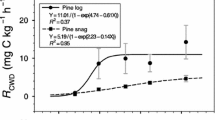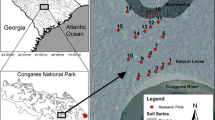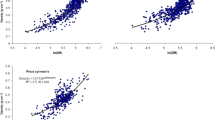Abstract
Background and aims
Carbon (C) loss from coarse woody debris (CWD) may be important in forest ecosystem C budgets, yet few studies have assessed CWD respiration in natural evergreen broad-leaved forests in subtropical China. The objectives of this study were (1) to quantify the respiration rates of downed logs (R log) and Q 10 of different tree species at various stages of decay, (2) to assess the effect of microclimatic (log temperature and moisture) variables on R log and (3) to estimate annual C flux of the CWD logs in four natural evergreen broad-leaved forest types of Altingia gracilipes Hemsl. (ALG), Tsoongiodendron odorum Chun (TSO), Castanopsis carlesii (Hemsl.) Hayata (CAC) and Cinnamomum chekiangense Nakai (CIC) in southern China.
Methods
A dynamic chamber method was used to measure R log in four decay classes (DCs) (ranging from freshly felled logs in DC 1 to highly decomposed logs in DC 4). The effects of changes in log temperature (T log) and log moisture content (M log) on R log were determined and annual R log estimated.
Results
The R log exhibited a distinct seasonal pattern, and it was predominantly controlled by the log temperature. The temperature sensitivity of R log to log temperature as indicated by Q 10 ranged from 1.82 to 2.86 and was variable among decay classes and forests. Significant relationships between moisture content of logs and R log were only observed for logs in the ALG (P = 0.001), TSO (P = 0.002) and CIC (P < 0.001). The log temperature in combination with the moisture of logs explained over 60 % of the variation in R log. The effects of decay class (F = 3.707, df = 3, P = 0.013) and tree species (F = 8.705, df = 3, P < 0.001) on R log were significant. Annual C fluxes ranged from 652 kg C ha−1 year−1 in the CIC to 1,243 kg C ha−1 year−1 in the TSO, with varying contributions from each decay class.
Conclusions
At these subtropical natural forests, R log was a significant component of overall heterotrophic respiration (about 10–20 % on the annual basis). With increasing climate change-associated tree mortality in our mature forests, CWD respiration is expected to increase. The results indicate that species, decay stage and microclimatic conditions should be considered when predicting CWD decay rates.





Similar content being viewed by others
References
Allen CD, Macalady AK, Chenchouni H, Bachelet D, McDowell N, Vennetier M, Kitzberger T, Rigling A, Breshears DD, Hogg EH, Gonzalez P, Fensham R, Zhang Z, Castro J, Demidova N, Lim JH, Allard G, Running SW, Semerci A, Cobb N (2010) A global overview of drought and heat-induced tree mortality reveals emerging climate change risks for forests. For Ecol Manag 259:660–684
Anderegg WRL, Kane JM, Anderegg LDL (2013) Consequences of widespread tree mortality triggered by drought and temperature stress. Nat Clim Chang 3:30–36
Barker JS (2008) Decomposition of Douglas-fir coarse woody debris in response to differing moisture content and initial heterotrophic colonization. For Ecol Manag 255:598–604
Bond-Lamberty B, Gower ST (2008) Decomposition and fragmentation of coarse woody debris: re-visiting a boreal black spruce chronosequence. Ecosystems 11:831–840
Bond-Lamberty B, Wang C, Gower ST (2003) Annual carbon flux from woody debris for a boreal black spruce fire chronosequence. J Geophys Res 108:8220
Bond-Lamberty B, Rocha AV, Calvin K, Holmes B, Wang C, Goulden ML (2014) Disturbance legacies and climate jointly drive tree growth and mortality in an intensively studied boreal forest. Glob Chang Biol 20:216–227
Chambers JQ, Higuchi N, Schimel JP, Ferreira LV, Melack JM (2000) Decomposition and carbon cycling of dead trees in tropical forests of the central Amazon. Oecologia 122:380–388
Chambers JQ, Schimel JP, Nobre AD (2001) Respiration from coarse wood litter in central Amazon forests. Biogeochemistry 52:115–131
Chen H, Harmon ME, Griffiths RP, Hicks W (2000) Effects of temperature and moisture on carbon respired from decomposing woody roots. For Ecol Manag 138:51–64
Currie WS, Nadelhoffer KJ (2002) The imprint of land-use history: patterns of carbon and nitrogen in downed woody debris at the Harvard Forest. Ecosystems 5:446–460
Davidson EA, Janssens IA, Luo YQ (2006) On the variability of respiration in terrestrial ecosystems: moving beyond Q10. Glob Chang Biol 12:154–164
Eaton JM, Lawrence D (2006) Woody debris stock and flux during succession in a dry tropical forest. For Ecol Manag 232:46–55
Edmonds RL, Vogt DJ, Sandberg DH, Driver CH (1986) Decomposition of Douglas-fir and red alder wood in clear-cuttings. Can J For Res 16:822–831
Erickson HE, Edmonds RL, Peterson CE (1985) Decomposition of logging residues in Douglas-fir, western hemlock, Pacific silver fir, and ponderosa pine ecosystems. Can J For Res 15:914–921
FAO (2009) Food and agriculture organization, FAOSTAT forestry database 2009. Available at http://faostat.fao.org; accessed on 1 November 2010
Forrester JA, Mladenoff DJ, Gower ST, Stoffel JL (2012) Interactions of temperature and moisture with respiration from coarse woody debris in experimental forest canopy gaps. For Ecol Manag 265:124–132
Foster JR, Lang GE (1982) Decomposition of red spruce and balsam fir boles in the White Mountains of New Hampshire. Can J For Res 12:617–626
Gough CM, Vogel CS, Kazanski C, Nagel L, Flower CE, Curtis PS (2007) Coarse woody debris and the carbon balance of a north temperate forest. For Ecol Manag 244:60–67
Guo JF, Chen GS, Xie JS, Yang ZJ, Yang YS (2014) Patterns of mass, carbon and nitrogen in coarse woody debris in five natural forests in southern China. Ann For Sci 71:585–594
Hagemann U, Moroni MT, Gleißner J, Makeschin F (2010) Disturbance history influences downed woody debris and soil respiration. For Ecol Manag 260:1762–1772
Harden JW, Trumbore SE, Stocks BJ, Hirsch A, Gower ST, O’Neill KP, Kasischke ES (2000) The role of fire in the boreal carbon budget. Glob Chang Biol 6:174–184
Harmon ME, Franklin JF, Swanson FJ, Sollins P, Gregory SV, Lattin JD, Anderson NH, Cline SP, Aumen NG, Sedell JR, Lienkaemper GW, Cromack K Jr, Cummins KW (1986) Ecology of coarse woody debris in temperate ecosystems. Adv Ecol Res 15:133–302
Harmon ME, Whigman DF, Sexton J, Olmstead I (1995) Decomposition and mass of woody detritus in the dry tropical forests of the northeastern Yucatan peninsula, Mexico. Biotropica 27:305–316
Harmon ME, Krankina ON, Sexton J (2000) Decomposition vectors: a new approach to estimating woody detritus decomposition dynamics. Can J For Res 30:76–84
Herrmann S, Bauhus J (2008) Comparison of methods to quantify respirational carbon loss of coarse woody debris. Can J For Res 38:2738–2745
Howard EA, Gower ST, Foley JA, Kucharik CJ (2004) Effects of logging on carbon dynamics of a jack pine forest in Saskatchewan, Canada. Glob Chang Biol 10:1267–1284
Intergovernmental Panel on Climate Change (IPCC) (2007) Climate change 2007: the physical science basis – summary for policy makers. Contribution of Working Group I to the Fourth Assessment Report of the Intergovernmental Panel on Climate Change. IPCC WGI 4th Assessment Report
Jomura M, Kominami Y, Tamai K, Miyama T, Goto Y, Dannoura M, Kanazawa Y (2007) The carbon budget of coarse woody debris in a temperate broad-leaved secondary forest in Japan. Tellus 59B:211–222
Jomura M, Kominami Y, Dannoura M, Kanazawa Y (2008) Spatial variation in respiration from coarse woody debris in a temperate secondary broad-leaved forest in Japan. For Ecol Manag 255:149–155
Kirschbaum MUF (1995) The temperature dependence of soil organic matter decomposition, and the effect of global warming on soil organic C storage. Soil Biol Biochem 27:753–760
Krankina ON, Harmon ME (1995) Dynamics of the dead wood carbon pool in northwestern Russian boreal forests. Water Air Soil Pollut 82:227–238
Kruys N, Jonsson BG, Stahl G (2002) A stage-based matrix model for decay-class dynamics of woody debris. Ecol Appl 12:773–781
Lin CF, Yang YS, Guo JF, Chen GS, Xie JS (2011) Fine root decomposition of evergreen broadleaved and coniferous tree species in mid-subtropical China: dynamics of dry mass, nutrient and organic fractions. Plant Soil 338:311–327
Liu WH, Bryant DM, Hutyra LR, Saleska SR, Hammond-Pyle E, Curran D, Wofsy SC (2006) Woody debris contribution to the carbon budget of selectively logged and maturing mid-latitude forests. Oecologia 148(1):108–117
Lloyd J, Taylor JA (1994) On the temperature dependence of soil respiration. Funct Ecol 8:315–323
Luo Y, Chen HYH (2013) Observations from old forests underestimate climate change effects on tree mortality. Nat Commun 4:1655
Mackensen J, Bauhus J (2003) Density loss and respiration rates in coarse woody debris of Pinus radiata, Eucalyptus regnans and Eucalyptus maculata. Soil Biol Biochem 35:177–186
Mackensen J, Bauhus J, Webber E (2003) Decomposition rates of coarse woody debris: a review with particular emphasis on Australian tree species. Aust J Bot 51:27–37
Manies KL, Harden JW, Bond-Lamberty BP, O’Neill KP (2005) Woody debris along an upland chronosequence in boreal Manitoba and its impact on long-term carbon storage. Can J For Res 35:472–482
Marra JL, Edmonds RL (1994) Coarse woody debris and forest floor respiration in an old-growth coniferous forest on the Olympic Peninsula, Washington, USA. Can J For Res 24:1811–1817
Mattson KG, Swank WT, Waide JB (1987) Decomposition of woody debris in a regenerating, clear-cut forest in the southern Appalachians. Can J For Res 17:712–721
Noormets A, McNulty SG, Domec JC, Gavazzi M, Sun G, King JS (2012) The role of harvest residue in rotation cycle carbon balance in loblolly pine plantations. Respiration partitioning approach. Glob Chang Biol 18:3186–3201
Olajuyigbe S, Tobin B, Nieuwenhuis M (2012) Temperature and moisture effects on respiration rate of decomposing logs in a Sitka spruce plantation in Ireland. Forestry 85:485–496
Phillips OL, Gentry AH (1994) Increasing turnover through time in tropical forests. Science 263:954–958
Pregitzer KS, Euskirchen ES (2004) Carbon cycling and storage in world forests: biome patterns related to forests age. Glob Chang Biol 10:2052–2077
Progar R, Schowalter T, Freitag C, Morrell J (2000) Respiration from coarse woody debris as affected by moisture and saprotroph functional diversity in Western Oregon. Oecologia 124:426–431
Sollins P, Cline SP, Verhoeven T, Sachs D, Spycher G (1987) Patterns of log decay in old-growth Douglas-fir forests. Can J For Res 17:1585–1595
Stone JN, MacKinnon A, Parminter JV, Lertzman KP (1998) Coarse woody debris decomposition documented over 65 years on southern Vancouver Island. Can J For Res 28:788–793
Tang XL, Zhou GY (2005) Coarse woody debris biomass and its potential contribution to the carbon cycle in successional subtropical forests of Southern China. Acta Phytoecologica Sin 29(4):559–568 (in Chinese with English abstract)
Tang JW, Bolstad PV, Desai AR, Martin JG, Cook BD, Davis KJ, Carey EV (2008) Ecosystem respiration and its components in an old-growth forest in the Great Lakes region of the United States. Agric For Meteorol 148:171–185
Tang JW, Bolstad PV, Martin JG (2009) Soil carbon fluxes and stocks in a Great Lakes forest chronosequence. Glob Chang Biol 15(1):145–155
van Mantgem PJ, Stephenson NL (2007) Apparent climatically induced increase of tree mortality rates in a temperate forest. Ecol Lett 10:909–916
Wang C, Bond-Lamberty B, Gower S (2002) Environmental controls on CO2 flux from black spruce coarse woody debris. Oecologia 132:374–381
Wu ZY (1980) Vegetation of China. Science Press, Beijing, p 825 (in Chinese)
Wu J, Zhang X, Wang H, Sun J, Guan D (2010) Respiration of downed logs in an old-growth temperate forest in north-eastern China. Scand J For Res 25:500–506
Yang YS, Guo JF, Chen GS, Xie JS, Gao R, Li Z, Jin Z (2005) Litter production, seasonal pattern and nutrient return in seven natural forests compared with a plantation in southern China. Forestry 78(4):403–415
Zell J, Kandler G, Hanewinkel M (2009) Predicting constant decay rates of coarse woody debris-A meta-analysis approach with a mixed model. Ecol Model 220:904–912
Acknowledgments
This work was financed by the National Natural Science Foundation of China (No. 31130013 and 31370615), the Excellent Youth Foundation of Fujian Educational Committee (JA11039), the Public Welfare Key Project of Fujian Technology Committee (K3-295) and the Key Project of Fujian Educational Committee (JA13065). We appreciate field assistance from Xudong He, Qiang Liu, Xiaofei Liu and Qunrui Zheng. We also thank Dr. Wenting Feng and two anonymous reviewers for their helpful comments and suggestions.
Author information
Authors and Affiliations
Corresponding authors
Additional information
Responsible Editor: Hans Lambers..
Rights and permissions
About this article
Cite this article
Guo, J., Chen, G., Xie, J. et al. Respiration of downed logs in four natural evergreen broad-leaved forests in subtropical China. Plant Soil 385, 149–163 (2014). https://doi.org/10.1007/s11104-014-2205-7
Received:
Accepted:
Published:
Issue Date:
DOI: https://doi.org/10.1007/s11104-014-2205-7




